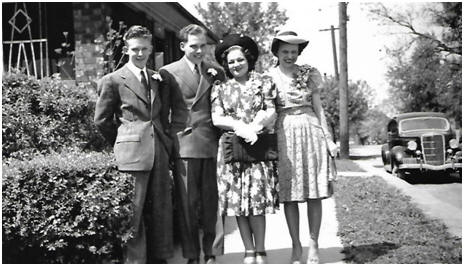
Chapter 9. 1941 to 1946: The Second World War Years
“John Ullian and Linda Ferraro: Roots and Legacy www.Ullian.org March 2018”
Summary
Mary Katherine Ullian
Mary married David Robert Larson on 3 May 1941 at Trinity United Methodist Church in Joliet, about 6 months before her twentieth birthday. The 1942 Joliet City Directory shows that they lived at 116 Briggs St., and he was an apprentice at American Can Company. The first 2 grandchildren of John and Linda Ullian were born to Mary and Dave during this period: David Ullian Larson in February 1943 and his brother Terry Wayne Larson in September 1945, both in Joliet. In about 1946, after having lived on Briggs St., Marcella Ave., and Circle Dr., Mary and Dave bought a house at 214 Anderson Ave. in Joliet.

Wedding Day: Bert Larson, David Larson, Mary (Ullian) Larson, and Rachel Larson
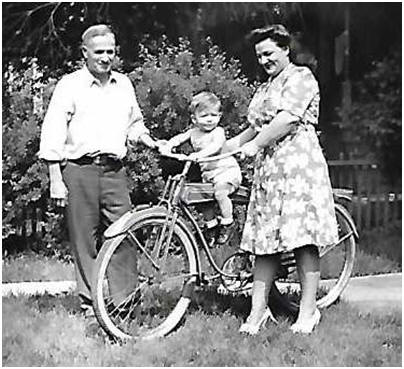
John Ullian with David U. Larson and Mary (Ullian) Larson – about 1944 or 1945
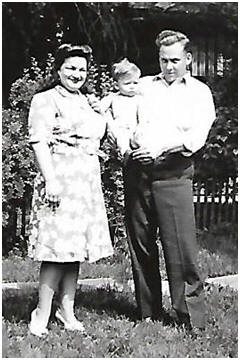
Mary, David U., and Dave Larson – about 1944 or 1945
John Anthony Ullian
[Note: In this section, all references to "John" are to John Anthony Ullian, not to his father.]
John A. Ullian’s first military experience occurred when he was in high school (University High) while living at the Illinois Soldiers’ and Sailors’ Children’s School in Normal IL. He was selected to participate in the Citizens’ Military Training Corps program at Fort Sheridan. The Fort was on Lake Michigan, north of Chicago, and within a few miles of his birthplace and the homes he had lived in prior to his mother’s death. The several participants selected from ISSCS went up together in a bus for the 6-week summer course. What he remembered most in his later years was the heavy artillery shooting into the lake, and crawling through the mud under fences with fake bombs going off. Afterwards at The Home, he wore his Fort Sheridan t-shirt proudly.
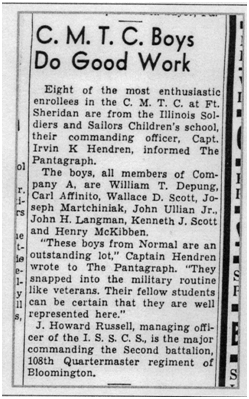
Pantagraph [Bloomington IL] 12 Jul 1940
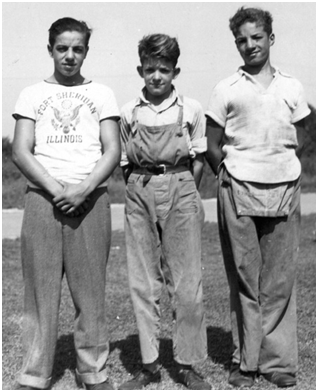
John A., Joe, and Gino Ullian at ISSCS
When Pearl Harbor was bombed, John A. and his brothers were still at ISSCS.
In 1942 John A. left ISSCS to live at 613 Morgan St. in Joliet with his foster parents Walter Ray Ruddy Sr. and his wife Marie. He lived with them most of the time between leaving The Home and entering the Army. He also lived for a short time with his father John in what he later remembered as a rented apartment in a brick building near a bowling alley. He worked at the A & P Grocery Store on S. Chicago St. in Joliet part of that time.
Mr. Ruddy worked as a prison guard, either at the Joliet Prison
[federal] or Stateville. John A. remembered that the children at The Home were bussed to one of the prisons for a visit "to scare us." That may have been the connection between The Home and Mr. Ruddy. In John A.’s words, "The state or The Home sent me to Joliet, and Mrs. Ruddy opted to take care of us, me and Joe Bartosch" [who had also been at The Home – spelling of surname uncertain]. "We both shared the room until we went into the service. Joey [Ullian] stayed with them too – not with me, later." Mr. Ruddy signed John’s Order to Report for Induction, on the line indicating he was a member or clerk of the local draft board.John A. loved the Ruddys. "They were like a mother and father to me. They were superb. When I left for the Army, I had a donut from the Red Cross, and the Ruddys were there saying goodbye, the band played, and away we went." He remembers watching Pat Ruddy, their younger son, go into the Navy. John A.’s wife, Mildred, has said that Mrs. Ruddy was so good that after they were married she and John A. often visited her, and eventually took the children with her. Every time the family visited the Ruddys, Mildred has said, the kids would sit quietly by the fireplace in their living room. The adults would talk, and the kids wouldn’t move – and Mrs. Ruddy always said that she never saw such good kids anywhere.
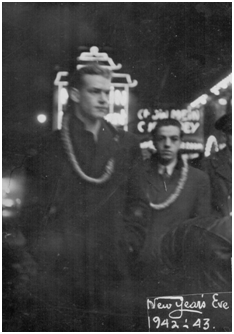
Doesn’t Look Like John’s Enjoying
New Year’s Eve in Chinatown 1942/43!
On 29 Jun 1942 John A. registered for the draft with an address of 116 S. Briggs St.
[his sister Mary’s address], Joliet IL. He was ordered to report to the local draft board at 126 N. Scott St., Joliet, for induction on 26 Apr 1943 – 10 days after his 20th birthday.
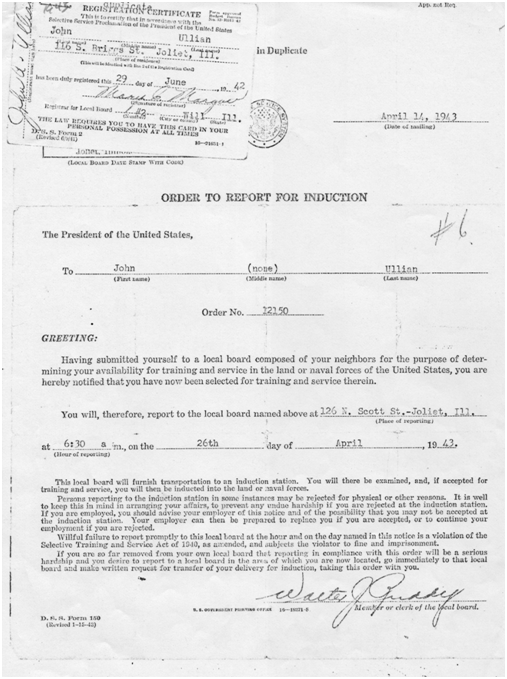
John A. Ullian’s Draft Card and Order to Report
John was assigned to the 475
th Military Police Escort Guard Company, which had been activated just a month earlier at Fort Custer MI, where the unit received its 11 weeks of basic training. The 475th MPEG Company’s primary roles in the service were to accompany, as military police, other Army units as they travelled within the U.S. and between the U.S. and Europe, and to bring prisoners of war (primarily German, and some Italian) from Europe to prisoner-of-war camps in the U.S.One of the members of the unit, Roland "Gene" Herbener, has a website with photos and stories about the unit – see http://475thmpeg.memorieshop.com for a much more extensive description of the unit’s activities than provided here.
Within the U.S., the unit’s primary duty stations were at Fort Custer MI, Camp Ellis IL, Hartford MI, and Camp Shanks NY. The unit also spent time at Fort Eustis VA, Camp Pickett VA, Camp Stewart GA, Swainsboro GA, Statesboro GA, Carlisle PA, and Indiantown Gap PA. Most of these sites served both as large training installations for the U.S. Army and later as POW camps.
In Europe, his unit primarily delivered U.S. servicemen to, and picked up prisoners of war from, Scotland (Grenock and Bay Gourock, both on the water near the Firth of Clyde) and England (with trips to Bristol, Bury, Moreton-in-Marsh, Cuddlington, and Southampton). On 11 Sep 1944, about 14 weeks after D-Day, the unit departed Southampton in LCI
[Landing Craft Infantry] #537 to arrive on Utah Beach, Normandy, at midnight. Two weeks later the unit departed Cherbourg, France, to bring their German prisoners of war to the U.S.Ships on which the unit sailed included HMS Eastern Prince, USAT
[U.S. Army Transport] George Washington, RMS Queen Elizabeth, LCI 537, MS John Ericsson [formerly MS Kungsholm], USAT Brazil, USAT Thomas H. Barry, USS General J. R. Brooke, and USS General G. O. Squier.Among the stories John A. recounted about his war experiences – and the only ones involving any sort of immediate danger – were those involving the unit’s two weeks in France. They are also recounted, in more detail than here, on Gene Herbener’s website.
The seas were rough when they were to land on Utah Beach. The LCI was not the most seaworthy vessel in rough water, and it landed safely only after several attempts – and at one point nearly capsized after listing some 55 degrees.
After landing, the unit marched from Utah Beach toward St. Marie du Mont. They were in a minefield briefly before recognizing their error and reversing course. No casualties.
One of the souvenirs picked up by a private turned out to be a live German rifle grenade. Told to get rid of it, he tossed it over a hedgerow, away from the campsite. There it exploded near an officers’ latrine, its existence there a surprise to the grenade thrower. Again, fortunately, no casualties (other than the latrine itself).
Finally, the continued existence of the 475
th MPEG Company itself and probably the safety of many of its soldiers were in jeopardy in December 1944. The Battle of the Bulge was raging and the Camp Commander told Captain Alex A. Levine, the Commanding Office of the 475th, to prepare to break up the unit in order to send men to serve as "filler" where needed in the units fighting that major battle. Capt. Levine successfully argued that the whole unit was needed for their current duties, guarding thousands of POWs with limited personnel at Prisoner of War Enclosure #1 near Moreton-in-Marsh, England. The unit remained whole, and alive.John A. had pleasant memories about the unit’s trip on the Queen Elizabeth, carrying 13,000 troops from New York to Scotland in 6 days from 28 Aug to 3 Sep1944. Unlike other ships the unit sailed on, the QE did not sail in a convoy for protection. She sailed alone, because she was fast enough to outrun a submarine. While the troops headed to Scotland had to sleep in 5-high racks or hammocks, the MPEG soldiers slept in staterooms – a touch of luxury even after the ship had been converted into a troop carrier.
John A. has said that he found guarding the POWs to be easier than dealing with the U.S. troops they escorted – he said that the POWs seemed to be grateful to be away from battle, to be treated well, and to have three meals a day – especially nearer the end of the war.
While his unit was at Camp Ellis John A. took advantage of the opportunity to visit the city where he had spent most of his life: Normal IL, some 90 miles from the camp. He may have gone back to Normal initially to visit his youngest brother, Joe, who was still at ISSCS at that time. Normal is the hometown of Mildred Maxine Huffington, whom John A. would marry in April 1946. Mildred’s home in Normal, at 406 E. Poplar Street, was on the route between ISSCS and downtown Normal, and her family was well-known to many of the children at The Home. Her mother was a sure touch for "Home kids" who needed an extra penny for candy at the downtown Saturday movies, and a friendly face for the kids just walking to town or University High School and back. Mildred remembers knowing Gino while he was at The Home, but didn’t know her husband-to-be John then. Gino encouraged Mildred to John was with his sister Livia when he met Mildred, on a trip from Camp Ellis. After that, John and Mildred wrote to each other and she sent him packages when he was away.
Gino has written about one time when he and his brother John crossed paths in the service. Gino visited him at Camp Ellis and wanted to take him to lunch, but John couldn't go because he was on guard duty. They paid another soldier $10 to take his shift. They went to lunch and Gino was going to pay, but "an old lady" paid for them, thanking them for serving in the military.
On 16 Feb 1946 John A. Ullian, PFC 36746699, 475th MPEG Company, received his Honorable Discharge from U. S. Army Separation Center, Camp Grant IL.
John A. Ullian enjoyed his time in the Army. He enjoyed the camaraderie of his fellow soldiers. His growing up in the Angel Guardian Orphanage and especially at ISSCS probably prepared him well for the social situation. He never had to use his gun (other than in basic training and to earn his Marksman badge). He enjoyed the "free" things he often received while on leave: drinks, movies, train rides, meals. He was proud to wear the uniform, just as he had been proud to wear the Fort Sheridan t-shirt in high school.
Private John Anthony Ullian, U.S. Army – 26 Apr 1943 to 16 Feb 1946
|
Shamrock Bar - Union City NJ
|
John with Army Buddy |
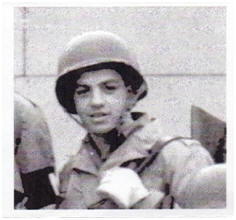 Close up of John from Unit Photo
|
|
Last day in the Army
|
With his sister Livia |
Joliet Herald News
|
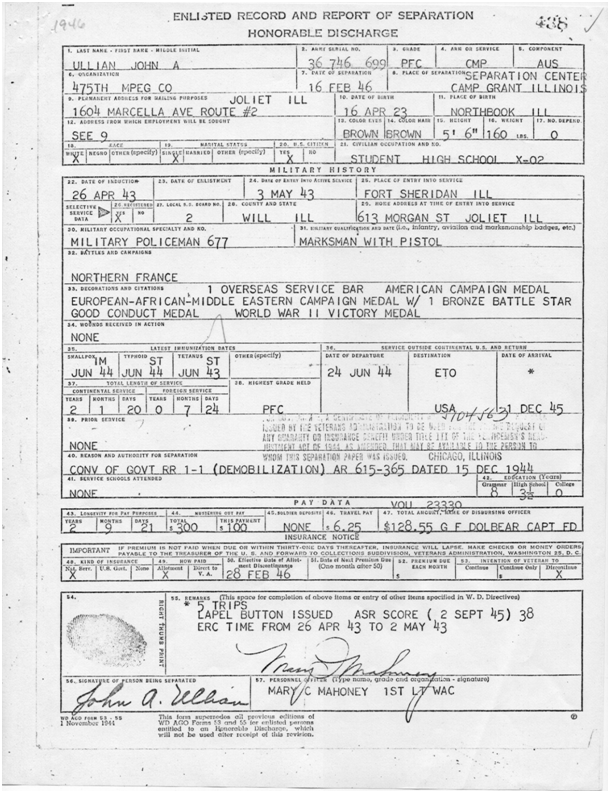
John A. Ullian’s Honorable Discharge
Livia Agnes Ullian
In 1941 Livia was in high school at Mount St. Mary’s Academy on the Fox River in St. Charles IL
[also known as Mount St Mary’s, or Mount Saint Mary Academy] during the school year, and lived with her foster family the Nealis sisters when not at school.
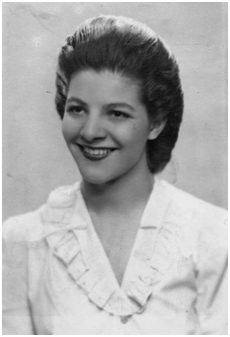
Livia about 18 Years Old
Livia’s ISSCS Discharge Summary, dated 20 Nov 1945, included the following: "When Livia became embroiled in a family argument she left the Nealis home on Easter, 1944, and made her home with her sister, Mrs. David Larson. In June 1944, she went to Joliet to stay permanently as she was told that because of her age it would be impossible for the Division to send her to school another year. During the summer of 1944 Livia had worked at the navy yard in Joliet and later went to her father’s home as he is now remarried. She now has another defense job and although her relationship with her father and stepmother is somewhat strained she is not interested in further supervision from the Division. If she does not like the family arrangement at home, she can go to the Larson home again to live. Because of Livia’s disinterest in further supervision from the Division, her age, and her ability to take [care] of herself, we are recommending discharge at the present time." This released her from foster care as a ward of the state.
Livia has told her daughter Linda Wysocki the stories below. She has told Linda about an incident that involved her brother John A. and their father. They were at the house on Marcella and their father asked Livia to move the car. Instead of putting the car in drive, she put it in reverse and almost ran them over – they had to jump into a ditch to avoid being run over. Livia didn’t drive a car before the incident, nor would she EVER drive again.
She remembers that her father loved to eat chicken, and they had several chickens. Her dad or Nina would catch a chicken and twist its neck. The chicken would run around the yard until finally it dropped dead. She said it was the craziest thing to watch. The chicken would then be cleaned and cooked. She also remembered that her father would shoot "sputzies" (sparrows) and cook and eat them. It took a lot of birds to get enough to eat.
Livia has told her daughter that while living with her father at 1604 Marcella she had abdominal surgery, possibly an appendectomy, and because she could not work for some time, her father threw her out of the house.
She worked at the Joliet Army Ammunition Plant
[locally called the Arsenal] in about 1944. She worked in the nail house, nailing the wooden lid on the boxes filled with TNT. Wooden crates with wax liners were filled with loose TNT and sent down the conveyor to box cars. She had to wear white cotton uniforms, gloves, and steel-toed shoes. She rode a bus to the change house and had to shower with orange soap. The midnight shift was the best because it was quieter. She left after about a year because she figured out that it was a dangerous place to work. Some workers (mostly women) had their skin and the whites of their eyes turn orange after a while on the job. After quitting her job, Livia traveled by bus to Grants Pass, Oregon, to visit her cousin Romey Ullian.Livia then lived in a room in the home of Gert Crowley at 210 Nicholson St. in Joliet. While living there, she worked at the American Institute of Laundering (as indicated in 1946 Joliet City Directory). She also worked at Visquine Sausage and at Goldblatt’s department store in Joliet.
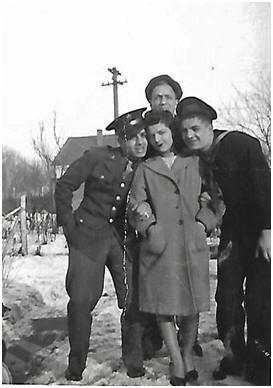
Livia with Brothers John, Gino, and her father John Ullian.
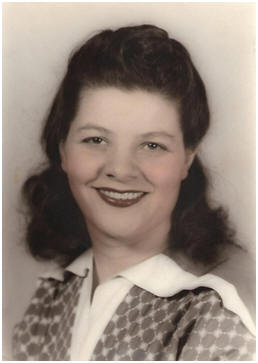
Livia Ullian
Gino Frank Ullian
Gino has written that "In my senior year, which was in 1942 after the war started, my Science teacher gave me an "F" on my report card in pencil. She said whoever had a failing mark in pencil could take the test over to improve their grade. The day the test came up she changed them all to ink. We got so mad we quit school. George (Eggie) Dogget, Herbie Downing and myself decided to join the Navy. We went to the managing officer’s office and asked if he would sign our papers to release us from the orphan’s home to join the Navy. He said no, to go back to school. We ended up threatening to throw Mr. Thorp out of the two story window if he didn’t sign. Well, he signed. The three of us were sworn in together. George was called first, Herbie second and I went in December 13, 1942."
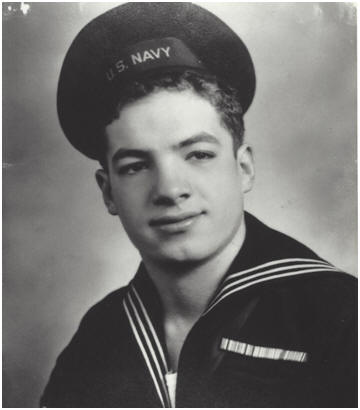
Gino Ullian
"After getting sworn into the U.S. Navy, I waited until I got called up. That happened the 30
th of December, 1942, so I was in Company 1 in Camp Moffett at the Great Lakes Training Station. I spent ten weeks in training then came home to my sister Mary’s house for a seven day furlough. That’s when I stayed also at 613 Morgan Street with my brother John. [That would have been in mid-March, about a month before his brother John’s April 26 induction into the Army.] After my furlough I was shipped to New York City on Long Island waiting for orders to board a ship. My first ship was a liberty ship, the Zebulon B. Vance. There were about twelve Navy men on it and the rest were Merchant Marines. We left New York Harbor and headed for Cuba. We hit a ten day storm off Cape Hatteras, Virginia [actually North Carolina – Gino was a Gunner’s Mate, not a navigator!] where I got my first taste of being seasick. I was green for the whole ten days.It was one of the worst sicknesses I ever recalled having. We got to Cuba just in time to see a tanker torpedoed in front of us so we were told not to stop but to proceed to the Panama Canal. We got to Panama and pulled some neat time ashore. One night we went to the George Washington Hotel right next to the ocean. There was a wedding going on so four of us Navy men went in uninvited. I cut the wedding cake while one guy danced the first dance with the bride. We ended up jumping in a swimming pool with our uniforms on."
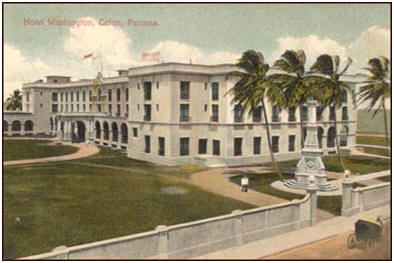
Hotel Washington, Panama
"After going through the canal it took us 93 days to get across the Pacific Ocean to Perth, Australia. While coming across we ran out of meat and lived on Spam and bread. After staying in Australia for three days, we headed for Abadan, Iran, in the Persian Gulf. We docked at an oil refinery where we refueled. We then proceeded to Bushire (spelled different in Iran as Persia). The captain wanted some fresh meat so he traded three jars of orange marmalade for a goat. He planned on eating the goat. We hit another storm going from Persia (Iran) to Durban, South Africa. Since I was the youngest man on the ship, they took my blanket for the goat to sleep on. The farther south we went, the colder we got and I wanted my blanket. Well, the goat got seasick and dirtied my blanket from both ends of him. Every time I went for my blanket, he chased me up the mast. I never got my blanket until we docked at Durban where the skipper gave the goat away. I dragged the blanket halfway across the Atlantic trying to get the stink out. While we were in Iran, the temperature got over 110 degrees so we had to work at night and sleep in the day. My job
[as a Gunner’s Mate] was to wet down all the ammunition with a wet mattress every 30 minutes to take the temperature down so it wouldn’t explode from the heat. I got a heat stroke and passed out from the heat. We rigged a shower on the stern of the ship. As soon as we left our quarters, we got wet but by the time we got to the front of the ship, we were dry only to have to get wet again to return to our quarters.""After leaving Durban, we docked at Capetown, South Africa, where we went to see the Zulu Tribe. I had some pictures taken with them. We then crossed the Atlantic and docked at Buenos Aires, Argentina, where we had a lot of fun while our ship was being loaded. I stayed in a hotel for two nights only to find out after we left that a rich uncle of ours owned it. I received a letter when we reached Trinidad to look him up if I ever got there, but it was too late."
[We have not identified the "rich uncle" in Buenos Aires.]"We got back to New York where I got a 14 day furlough. I received my pay of $328.00 for the eight months that I was at sea. I came home and saw my sisters, Mary and Livia, and my dad. John, my brother, was an M.P. guarding German Prisoners at a camp down south near Rantoul, Illinois
[Camp Ellis], so I went to see him. I later went to Danville to see the redhead that I was going with. After returning to New York I was shipped to an Upper State Rest Camp where I met a first cousin of mine named Pio Ferraro for the first time. It was a very nice resort in the mountains where the scenery was beautiful. We went to town every night and had a ball. After leaving there and stopping at Long Island, New York, I went to Norfolk, Virginia. From there I was sent to Crane, Indiana to catch LST [Landing Ship – Tank] 690 which was a flat bottom landing ship used to hit the beaches during invasions. We took the LST 690 down the Mississippi River to New Orleans where we practiced landings on the beaches. We then proceeded to the Atlantic where we convoyed with another 107 ships and proceeded with them to North Africa. After passing the Rock of Gibraltar, we were attacked by German torpedo planes. It was at night and we were on the corner of the convoy because we had 500 tons of black powder on board ship. A JU [Junker] 88 dropped a torpedo which went two feet in front of our ship. I think if it would have hit us, we would still be going up.""After unloading our cargo at Tunisia, North Africa, we proceeded to Naples, Italy, where we picked up a load of tanks and a lot of Army personnel. We landed on the beaches of Southern France, not getting too much action from the Germans. LST 73 was alongside of us. She lost her stern anchor so she couldn’t get off the beach. She was hit with a V-2 rocket that blew her to pieces. Only three people survived."
"After going to Salerno, Sicily,
[Note: Salerno is the name of a province in Italy and of the capital city of that province, in the region of Campania. It is not in Sicily.] we took a couple of loads back to the beach. In a couple of days I was sent home to get another ship. Again I boarded an LST. This number was LST 1103. After more training runs with this second ship, I again went through the Panama Canal only to head north to Hawaii. After leaving Pearl Harbor, we went south to different islands such as the Solomons, Guam, Tarawa, Eniwetok, Okinawa, Marshall Islands, and others. We went to Yap Island and picked up a load of Japanese prisoners. While taking them south to Guam, we were given orders to proceed and load up for the invasion of Japan. That was just before they dropped the atomic bomb on Japan. We had the prisoners onboard ship when we heard the war was over. We had all the Japanese prisoners throw all our ammunition overboard.""After I got enough points to get discharged, I boarded the U.S.S. Henrico and came home to California. It took five days on a troop train to get to Chicago. I was discharged honorably the 16th of February 1946."
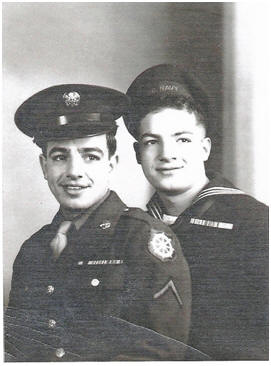
John A. and Gino Ullian
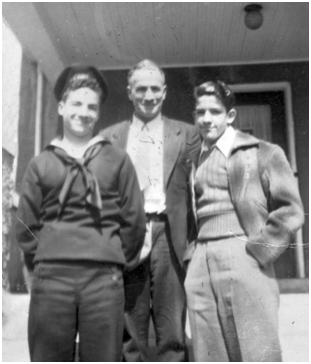
Gino, "Proud Papa" John, and Joe Ullian

Joliet Herald News
[Joliet IL] 24 Feb 1946
Brothers Serve U.S. on Opposite Sides of World
Discharges came double at the home of John Ullian, Sr, 1604 Marcella avenue, when two of his sons, GM2/c Gino and Pfc John Jr., arrived home only two days apart. / In service since May, 1943, Pfc. John was discharged from Camp Grant February 16. He was stationed overseas at Cherbourg France, where he was a member of a military police battalion. He returned to the states in December. He wears the American and European theater ribbons and the Victory medal. / His navy brother was discharged at Great Lakes last Monday. He entered the navy in December, 1942, and spent 23 months overseas. During the 23 months, he traveled completely around the world and visited six continents, crossing the equator four times. He served aboard three ships, the SS Zebulon B. Vance, the LST 690, and the LST 1103. With him on his sea-going trip was his cocker spaniel, "Queenie," who became the ship's mascot. / Seaman Ullian has the Asiatic-Pacific ribbon, the Victory medal and the American area ribbon. He returned to the states February 8. / Another brother, Pfc. Joseph Ullian, 18, is stationed in the army of occupation in Japan. He has been in service one year."
Joseph Francis Ullian
On 16 Aug 1943, Joe was discharged from ISSCS and went to foster care in Joliet. He was not quite 17 years old at the time. Joe did not graduate from grade school (he said that he was never a good student). When he came to Joliet, Joe’s father would not let him continue in school – he told Joe he had to work. At some point after leaving ISSCS, and after his brother John A. entered the Army, Joe lived briefly with John’s foster parents, the Ruddys. It is not clear whether they were also Joe’s foster parents. The 1945 Joliet City Directory (probably showing information for some time in 1944 or perhaps earlier) showed that Joe and his father both worked at Farrell Manufacturing on Cass St., located west of the Des Plaines River
[called "The Canal" in Joliet.] Farrell manufactured depth charges and land mines at the time. That directory indicated that they lived at 67 N. Eastern Ave.Joe provided his niece Linda Wysocki with the following information in December 2013. He lived with his father at 1604 Marcella before going into the Army. Joe has said that his father would take him to the tavern after work and have a sandwich and a beer, and young Joe thought it was pretty cool to be able to sit on the bar stool. He entered the U.S. Army in about 1944 or 1945. He went to basic training in Arkansas, advanced training in Texas, and then was shipped to the West Coast to take a ship to Japan. He said he was seasick the whole time the ship was sailing to Japan. Joe served with the 11
th Airborne and was stationed on the island of Hokkaido in northern Japan as a truck driver, and remembered that it snowed there. After the war, he took a merchant marine ship back to the states. Joe enjoyed being in the Army.After returning from the Army, Joe moved back to Joliet, to live with his father John and step-mother Nina at 1604 Marcella Ave. He returned to work at Farrell Manufacturing, according to the 1947 Joliet City Directory.
Where was John from 1941 to 1946?
We know that John was in Houston TX for at least part of the 1930s and the early 1940s. He came back permanently to Joliet IL by 1944.
John received a "duplicate original" of his Certificate of Naturalization on 9 Feb 1942, when he lived at 1103½ Franklin Avenue, Houston TX; application No. 17-B-932
. [The 1971 Houston City Directory showed that the Franklin Hotel was at 1103 1/2 Franklin, which is near the north edge of downtown Houston.] The personal description showed that in 1942 he was 51 years old, with fair complexion, brown eyes/hair, 5’6," 150 pounds, with no distinctive marks, a widower, and formerly an Italian national.
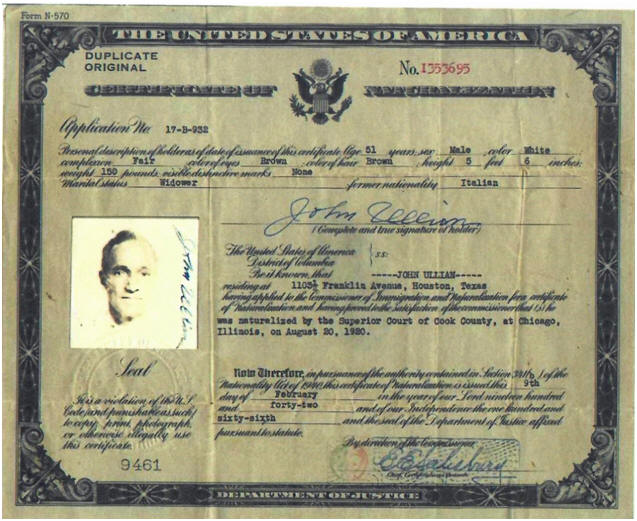
John Ullian’s Certificate of Naturalization
John filled out his World War II draft registration card on 27 Apr 1942, serial number U 1773. He gave as his place of residence the address of his employer: N.J. Smith Supply Co., 7616 Eureka, Houston, Harris, Texas (which was also given as the "name and address of person who will always know your address"). His mailing address was Box 7398, Houston, Texas; telephone number 6111 (business). He listed his birth as 5 Sep 1890, in Italy; age 51. It showed him as 5’6" tall, 150 pounds, brown eyes/hair, dark complexion, with a scar on left upper arm.
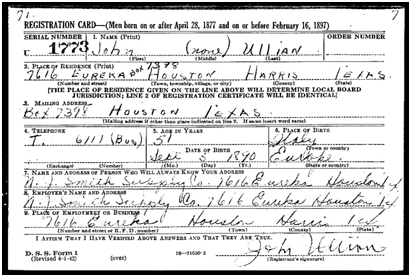
John Ullian’s World War II Draft Registration Card
[From Ancestry.com]
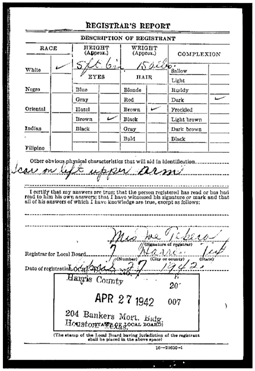
Back of Card
As mentioned above in the discussion about his son Joe, John was shown in the 1945 Joliet City Directory to work at Farrell Manufacturing on Cass St., and lived at 67 N. Eastern Ave. We believe that this directory probably shows where John and Joe lived in 1943, or early 1944, before John’s marriage to Nina. After working at Farrell, John worked at Joliet Heating Company. He later resumed landscaping – whether on a full-time or part-time basis we do not know.
On Saturday 29 January 1944, a marriage license was issued for Mr. John Ullian (53 years old) and Mrs. Domenica Salbego (44 years old) in Joliet by the County Clerk. They were married that same day by John P. Egan, Justice of the Peace, 59 S. Chicago St. The witnesses were Ruth Murphy and Frank Campbell.
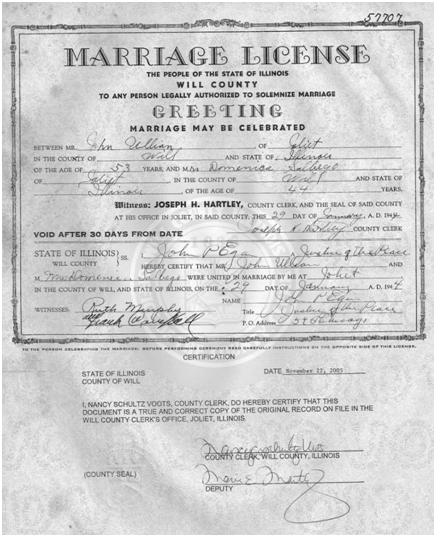
Mr. John Ullian and Mrs. Domenica Salbego’s Marriage License
Domenica (Velo) Salbego Ullian – Nina
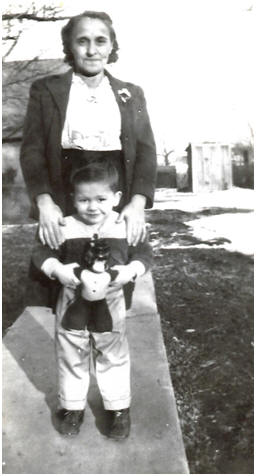
Nina Ullian with David Larson about 1945
Domenica Velo was born in Italy on 10 Aug 1899 to Giovachino
[Joe] Velo and Madalina [Madeline] Gregiani. She immigrated (presumably with her parents) to the U.S. in 1913.On 24 Apr 1919 Domenica married Bartolo/Bortolo Salbego in Vermillion County, Indiana. Her father, Joe Velo, was listed as a miner on their Application for Marriage License. The certificate for the birth of their daughter Edith/Ida on 5 Sep 1921 in Shirkieville, Vigo, Indiana, showed Bartolo as a coal miner, and the family living in Paris, Edgar, Illinois.
Domenica’s parents Giovachino and Madeline Velo were listed in the Fairview
[possibly the current town of Fairview Park, just north of Clinton] section of the 1922 City Directory for Clinton, Vermillion, Indiana. He was a miner at Crown Hill, and their address was RR 4, Lincoln.When enumerated on 8 Apr 1930 for the Federal Census, "Mary"
[Domenica] Velo was listed with her daughter Ida on Hollingsworth Road in Shirkieville, Vigo, Indiana. Bartolo was not listed with them, though "Mary" was listed as married rather than divorced. "Mary" is listed as a 30-year-old married woman born in Italy, first married at age 19. Her daughter Ida was 8 years old and was born in Indiana. Shirkieville IN (where she had given birth to Ida) is between Clinton IN (where her parents lived) and Paris IL (where she and Bartolo had lived) – about 11 miles from each. Perhaps she moved there when separated but not yet divorced from Bartolo.When Nina’s father Joseph Velo was enumerated on 17 May 1930 for the Federal Census in Highland Park IL, he was a 54-year-old gardener born in Italy. His wife Madaline was 50 years old and born in Italy. Daughter Alice was 19 years old and born in Illinois; son Armando was 15 years old and born in Indiana; and daughter Gloria was 8 years old and born in Indiana. Two roomers lived with them in a rented house at 725 Deerfield Ave., Highland Park IL. Nina (about 30 years old) did not live with them in 1930. Joseph was 33 when first married, Madaline was 31 when first married: thus they were married about 1900. Domenica was born in 1899.
In 1935, Nina Salbego and her daughter Ida Salbego lived in Highland Park IL, but not in the same house where they would later live at the time of the 1940 census.
The 1940 Houston City Directory (probably showing information from 1939 or even earlier) shows Nina with a Ullian, who is a landscaper, living at 501 Anita.
When enumerated on 19 Apr 1940 for the Federal Census, 40-year-old Nina Salbego (born in Italy) was divorced and living in the household of her widowed 63-year-old father Joseph (born in Italy) with her 18-year-old daughter Ida Salbego (born in Indiana) in a rented house at 153 N. Greenbay Road in Highland Park IL. Others in that house were Joseph’s 18-year-old single daughter Gloria (born in Indiana), his 39-year-old son Dominic (born in Italy) and Dominic’s 40-year-old wife Myrtle (born in Missouri), as well as a lodger. That census shows that Nina worked as a maid in a private home (80 hours in a specific week asked about on the Census), earned $390 in 1939, and had additional non-wage income of $50 or more that year. Nina was not a U.S. citizen; Joseph and Dominic had their "first papers."
On 28 Apr 1941 Domenica Seconda Salbego, born in Italy on 10 Aug 1899, received her U.S. citizenship from the Circuit Court in Waukegan, Lake, Illinois. The naturalization record showed that she lived at 153 N. Greenbay
[Green Bay] Road, Highland Park IL (where she lived at the time of the 1940 U.S. Census). Her witnesses were Frank Passuello of the same 153 N. Greenbay [Green Bay] Rd. address, and Francesco Perin of 4501 Elm Pl. in Highland Park. Passuelo was not the lodger enumerated with Nina’s family at the 1940 Federal Census.Regarding the "Seconda" in her name on her naturalization record index card, it may refer to the fact that her father’s mother’s maiden name was Domenica Tescari, and thus Nina’s grandmother’s married name was Domenica Velo. Our Nina had been the second Domenica Velo. We have not found the Seconda in her name elsewhere.
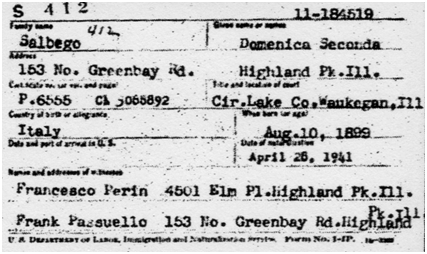
Nina’s Naturalization Record – 1941
Domenica’s father filled out his World War 2 draft registration card on 27 Apr 1942 as Giovachino Velo, 153 N. Green Bay Rd., Highland Park IL, 64 years old, born in Venice, Italy on 15 Aug 1877. He was a laborer, and listed his wife as Maralena, with the same address.
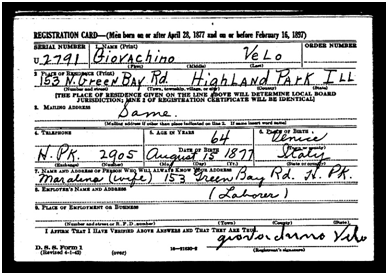
Giovachino
[Joe] Velo’s World War II Draft Registration Card
Nina and John were married in January 1944, and around then they moved to 1604 Marcella Ave. in Joliet. The property was known as "The Farm" by the family. See Chapter 10 for more information on this property.